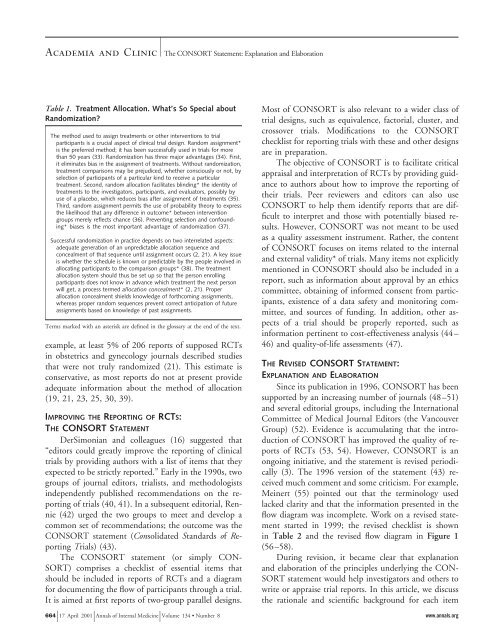The Revised CONSORT Statement for Reporting Randomized Trials
The Revised CONSORT Statement for Reporting Randomized Trials
The Revised CONSORT Statement for Reporting Randomized Trials
You also want an ePaper? Increase the reach of your titles
YUMPU automatically turns print PDFs into web optimized ePapers that Google loves.
Academia and Clinic <strong>The</strong> <strong>CONSORT</strong> <strong>Statement</strong>: Explanation and Elaboration<br />
Table 1. Treatment Allocation. What’s So Special about<br />
Randomization?<br />
<strong>The</strong> method used to assign treatments or other interventions to trial<br />
participants is a crucial aspect of clinical trial design. Random assignment*<br />
is the preferred method; it has been successfully used in trials <strong>for</strong> more<br />
than 50 years (33). Randomization has three major advantages (34). First,<br />
it eliminates bias in the assignment of treatments. Without randomization,<br />
treatment comparisons may be prejudiced, whether consciously or not, by<br />
selection of participants of a particular kind to receive a particular<br />
treatment. Second, random allocation facilitates blinding* the identity of<br />
treatments to the investigators, participants, and evaluators, possibly by<br />
use of a placebo, which reduces bias after assignment of treatments (35).<br />
Third, random assignment permits the use of probability theory to express<br />
the likelihood that any difference in outcome* between intervention<br />
groups merely reflects chance (36). Preventing selection and confounding*<br />
biases is the most important advantage of randomization (37).<br />
Successful randomization in practice depends on two interrelated aspects:<br />
adequate generation of an unpredictable allocation sequence and<br />
concealment of that sequence until assignment occurs (2, 21). A key issue<br />
is whether the schedule is known or predictable by the people involved in<br />
allocating participants to the comparison groups* (38). <strong>The</strong> treatment<br />
allocation system should thus be set up so that the person enrolling<br />
participants does not know in advance which treatment the next person<br />
will get, a process termed allocation concealment* (2, 21). Proper<br />
allocation concealment shields knowledge of <strong>for</strong>thcoming assignments,<br />
whereas proper random sequences prevent correct anticipation of future<br />
assignments based on knowledge of past assignments.<br />
Terms marked with an asterisk are defined in the glossary at the end of the text.<br />
example, at least 5% of 206 reports of supposed RCTs<br />
in obstetrics and gynecology journals described studies<br />
that were not truly randomized (21). This estimate is<br />
conservative, as most reports do not at present provide<br />
adequate in<strong>for</strong>mation about the method of allocation<br />
(19, 21, 23, 25, 30, 39).<br />
IMPROVING THE REPORTING OF RCTS:<br />
THE <strong>CONSORT</strong> STATEMENT<br />
DerSimonian and colleagues (16) suggested that<br />
“editors could greatly improve the reporting of clinical<br />
trials by providing authors with a list of items that they<br />
expected to be strictly reported.” Early in the 1990s, two<br />
groups of journal editors, trialists, and methodologists<br />
independently published recommendations on the reporting<br />
of trials (40, 41). In a subsequent editorial, Rennie<br />
(42) urged the two groups to meet and develop a<br />
common set of recommendations; the outcome was the<br />
<strong>CONSORT</strong> statement (Consolidated Standards of <strong>Reporting</strong><br />
<strong>Trials</strong>) (43).<br />
<strong>The</strong> <strong>CONSORT</strong> statement (or simply CON-<br />
SORT) comprises a checklist of essential items that<br />
should be included in reports of RCTs and a diagram<br />
<strong>for</strong> documenting the flow of participants through a trial.<br />
It is aimed at first reports of two-group parallel designs.<br />
Most of <strong>CONSORT</strong> is also relevant to a wider class of<br />
trial designs, such as equivalence, factorial, cluster, and<br />
crossover trials. Modifications to the <strong>CONSORT</strong><br />
checklist <strong>for</strong> reporting trials with these and other designs<br />
are in preparation.<br />
<strong>The</strong> objective of <strong>CONSORT</strong> is to facilitate critical<br />
appraisal and interpretation of RCTs by providing guidance<br />
to authors about how to improve the reporting of<br />
their trials. Peer reviewers and editors can also use<br />
<strong>CONSORT</strong> to help them identify reports that are difficult<br />
to interpret and those with potentially biased results.<br />
However, <strong>CONSORT</strong> was not meant to be used<br />
as a quality assessment instrument. Rather, the content<br />
of <strong>CONSORT</strong> focuses on items related to the internal<br />
and external validity* of trials. Many items not explicitly<br />
mentioned in <strong>CONSORT</strong> should also be included in a<br />
report, such as in<strong>for</strong>mation about approval by an ethics<br />
committee, obtaining of in<strong>for</strong>med consent from participants,<br />
existence of a data safety and monitoring committee,<br />
and sources of funding. In addition, other aspects<br />
of a trial should be properly reported, such as<br />
in<strong>for</strong>mation pertinent to cost-effectiveness analysis (44–<br />
46) and quality-of-life assessments (47).<br />
THE REVISED <strong>CONSORT</strong> STATEMENT:<br />
EXPLANATION AND ELABORATION<br />
Since its publication in 1996, <strong>CONSORT</strong> has been<br />
supported by an increasing number of journals (48–51)<br />
and several editorial groups, including the International<br />
Committee of Medical Journal Editors (the Vancouver<br />
Group) (52). Evidence is accumulating that the introduction<br />
of <strong>CONSORT</strong> has improved the quality of reports<br />
of RCTs (53, 54). However, <strong>CONSORT</strong> is an<br />
ongoing initiative, and the statement is revised periodically<br />
(3). <strong>The</strong> 1996 version of the statement (43) received<br />
much comment and some criticism. For example,<br />
Meinert (55) pointed out that the terminology used<br />
lacked clarity and that the in<strong>for</strong>mation presented in the<br />
flow diagram was incomplete. Work on a revised statement<br />
started in 1999; the revised checklist is shown<br />
in Table 2 and the revised flow diagram in Figure 1<br />
(56–58).<br />
During revision, it became clear that explanation<br />
and elaboration of the principles underlying the CON-<br />
SORT statement would help investigators and others to<br />
write or appraise trial reports. In this article, we discuss<br />
the rationale and scientific background <strong>for</strong> each item<br />
664 17 April 2001 Annals of Internal Medicine Volume 134 • Number 8 www.annals.org
















